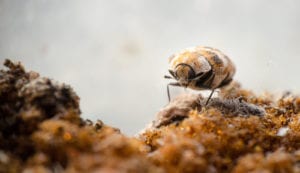
There are many types of beetles in the world. These insects eat everything from leaves to trees and even carpet.
Carpet beetles are common household pests that can do serious damage if not exterminated quickly. While these insects are sometimes mistaken for bed bugs, they are actually a distinct species that must be managed in a very specific way.
This article will cover everything homeowners need to know about carpet beetles, including how to identify them, the risks of having them in your home, and how to get rid of carpet beetle larvae.
What Are Carpet Beetles?
The varied carpet beetle, the black carpet beetle, and the furniture carpet beetle are three common types of pests in homes. The varied carpet beetle is about 1/10 inch long and often black with patterns of brown, white, and dark yellow colored scales. Furniture carpet beetles are a little larger than this and have a more mottled appearance. Finally, black carpet beetles are between 1/8 and 3/16 inch long and are shiny black in color.
All of these types of beetles lay eggs on a food source, such as carpet or fabric. After about two weeks, the eggs hatch into carpet beetle larvae that feed, burrow, and leave behind particles of skin and feces.
Risks of Having Carpet Beetles in Your Home
What makes these insects so problematic in the home is their diet. These pests love eating fibrous materials, such as carpet, furniture, blankets, leather, and clothing. However, they’ll also gladly eat lint, hair, animal nests, and dead insects too. Occasionally, carpet beetles will eat grains and spices from your pantry as well. Not only can this feeding damage fibers in your home, but the waste left behind by carpet beetle larvae can cause health problems if touched or ingested.
Carpet Beetle Bites
One common question homeowners ask is “Do carpet beetles bite?” While bed bugs love to feed on human blood, carpet beetles prefer plants and fibrous materials. This means that carpet beetle bites on humans don’t actually exist. You may notice little red bumps on your skin when you have carpet beetles in your home, but these are not carpet beetle bites. Instead, these are signs of an allergic reaction to traces of a carpet beetle’s blood or to the hairs on carpet beetle larvae.
How to Deal with a Carpet Beetle Infestation
A carpet beetle infestation can be very difficult to manage because of the pest’s ability to find food in so many different places. If larvae are found in household fabrics, it is time to call a professional exterminator for help. A carpet beetle management plan may involve placing sticky traps bated with a pheromone to attract the beetles. Traps can get rid of current pests and also track problem areas in the home where they are most prevalent.
After identifying the source of carpet beetles, it is a good idea to use a vacuum thoroughly to collect them and all carpet beetle larvae and then wash all affected fabrics in hot, soapy water. Treatments with boric acid or that contain chlorpyrifos and bendiocarbs may also be used to control these pests. It’s also important to check clothes and blankets that you keep in storage for potential carpet beetle infestations because improperly stored fabrics are common breeding grounds for carpet beetles.
If you’re home has been infested by carpet beetles, call the pest control experts at Precise Pest Control. Call 866-971-2847 or contact us online for a free consultation!
